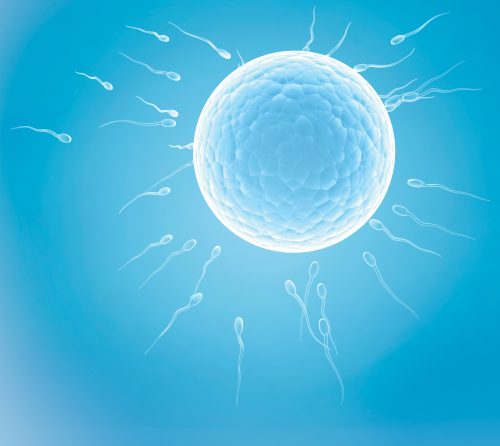
Much of the time when we think of fertility problems the focus is on women. Gynaecologist Dr Andrew Murray explains the good, the bad and the ugly of male fertility.
When it comes to fertility problems, often, the initial focus is on women. Female fertility seems so complex compared to men, with ovulation, periods, fallopian tubes… Men, well they just have to point and shoot.
But is it as simple as that? What about the bullets?
It is now well documented that men’s sperm counts are declining. In fact, research from Fertility Associates published two years ago has shown that in the past 20 years the average concentration of sperm among donors has halved. The scary thing is we don’t know why. Theories include environmental factors such as oestrogens from the contraceptive pill getting into the water supply, pesticides on our vegetables and fruit and laptops and mobile phones irradiating our blokes’ testes. There is really no proof, and the ‘average’ count in the general population, although lower, is still considered fertile.
So what is bad for sperm? Think of sperm as DNA delivery vans — the sole purpose of a sperm is to deliver the male’s DNA to his partner’s egg. A sperm count simply counts how many vans you have and how fast they drive. Sperm DNA is the cargo inside the van.
Risk factors for damage to the cargo include smoking (both tobacco and cannabis), heat, obesity, alcohol excess, previous testicular surgery or injury, and interestingly, long-distance cycling. Cannabis smokers tend to have very poor sperm motility — it’s almost like the sperm are stoned, too. The DNA damage is due to ‘free radicals’, and the worrying thing is this damage can lead to not only fertility issues but also miscarriages, and an increase in the risk of cancer developing in the children of any ‘successful’ pregnancies.
Sperm can also be abnormally shaped — the delivery vans are bent out of shape. A lot of sperm is misshapen. In fact, only four per cent need to be of normal shapes for normal fertility. Below this can be associated with reduced fertility.
When fertility experts assess male fertility, we don’t just count the vans and how fast they move. We can also assess the shape (morphology) and we can also measure DNA damage. A thorough sperm assessment like this is well worth it to know what’s going on.
What can a man do?
The good news is that the factory where sperm are made (the testes) is sending out new models every 72 days. This gives us an opportunity to ‘modify’ the production line.
To reduce the impact of free radicals, a diet high in antioxidants will help. Think of colourful fruits and vegetables — greens, reds, blues — they all contain heaps of vitamin C. Foods such as peanuts, Brazil nuts and almonds contain zinc and vitamin E which also help. Cooked tomatoes contain a powerful antioxidant called lycopene, which is also useful for this problem. There are also commercial preparations containing all of these that can be taken as a daily supplement.
Sperm fitness can also be improved by addressing excess weight. There is no advantage having a big roof over the tool shed! If you can’t see your manhood when you look down — there is a problem. It’s time to get off the couch, get that laptop off your nuts, and get moving!
Avoiding excess alcohol, stopping smoking and kicking the weed into touch are also important — none of these are doing sperm any favours.
Ideally, these things should be addressed before starting to try and conceive.
If you’re having problems conceiving, look at the bigger picture and find out what kind of bullets you’re firing.
Foods to boost a fella’s fertility
Breakfast
- Instead of white toast and jam, TRY two boiled eggs and wholemeal toast. Eggs are a decent source of selenium and are relatively low kilojoule. Plus, this combo of protein from the eggs and fibre from the wholemeal toast will keep you going until lunch without the need to snack.
- Instead of Crunchy Nut Cornflakes, TRY porridge topped with selenium-rich Brazil nuts. Not only do you get the fertility boost from selenium but the low glycaemic index (GI) of the porridge means it will reduce temptation to snack unhealthily.
Lunch
- Instead of a cheese and pickle sandwich, TRY a tuna and red capsicum sandwich to boost selenium and carotenoids, accompanied by a green side salad.
- Instead of a meat pie, TRY a salad loaded with different leafy greens, grated carrot for its carotenoids, canned salmon for its omega-3 fats and selenium, drizzled with a little olive oil.
Dinner
- Instead of pasta with a creamy sauce, TRY a stir-fry with skinless chicken breast, broccoli, carrots and baby spinach.
- Instead of steak and potatoes, TRY grilled salmon for its omega-3 and selenium combo, baked kumara and plenty of green vegetables: a meal packed with fertility-boosting nutrients.
Article sources and references
- Shine R et al. 2008. Declining sperm quality in New Zealand over 20 years. New Zealand Medical Journal http://www.nzma.org.nz/journal/ 121-1287/3416/http://www.nzma.org.nz/journal
www.healthyfood.com










